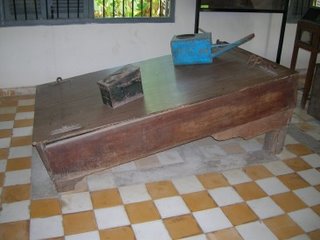
Khmer Rouge waterboard (Tuol Sleng Prison, Phnom Penh, Cambodia).
The Japanese used waterboarding against Allied soldiers during World War II. Waterboarding was used around 1968 by U S soldiers interrogating captured North Vietnamese soldiers during the Vietnam War. Later on, Cambodia's Khmer Rouge used waterboarding against supposed class enemies.
More recently, the Americans are reported to have used waterboarding against alleged members of Al-Qaeda including Khalid Sheikh Mohammed -- the supposed mastermind of the aerial attack against financial, military and political targets in the USA on 11 September, 2001.
Usually, a towel is positioned over the (often blindfolded) detainee's mouth. The Americans, however, are reported to have used taped Saran-wrap, which muffles the detainee and has the further advantages of blocking oral breathing as well as impeding the expulsion of water by way of the mouth.
Either way, because your head is lower than your feet, the water courses down your nostrils and fills the back of your throat. Sooner or later you are going to have to swallow that water. You can't get away from the water because you are tied down. It's difficult to breathe, and the water is going into your stomach, or ends up in your lungs.
By all accounts, it doesn't take long to give in - about two and a half minutes, about as long as you can hold your breath. And while there is water, your torturer can repeat the procedure all day.
Photo (above) and more about the history and uses of waterboarding: david corn
No comments:
Post a Comment